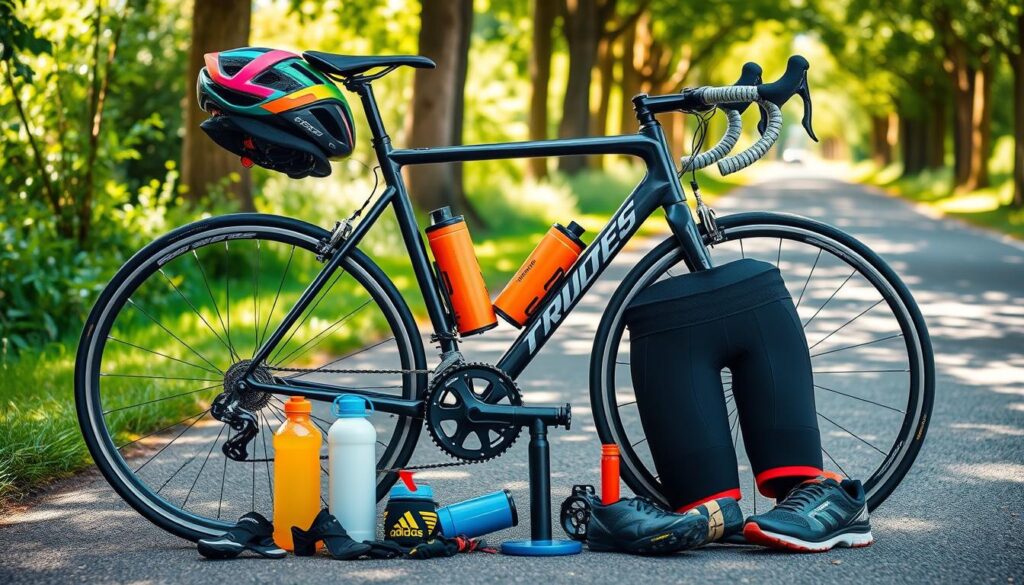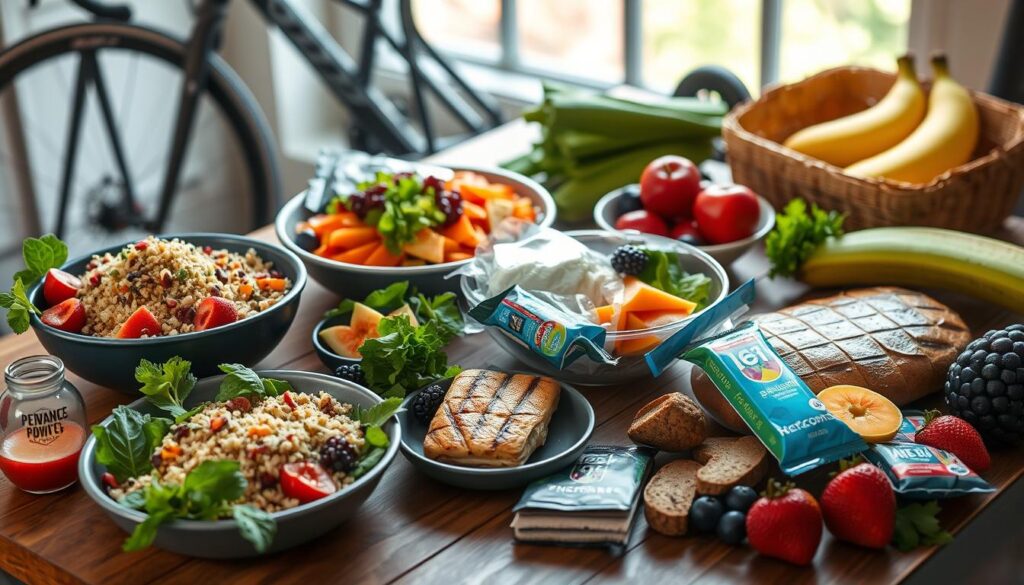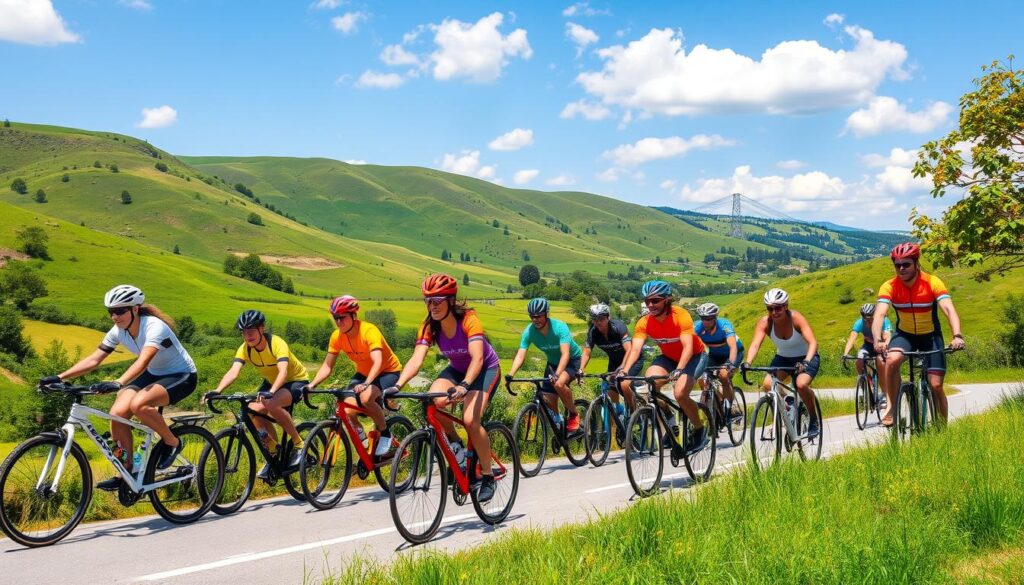Cycling is a great way to lose weight. It’s easy on your body and can be done indoors or outdoors. You can ride a bike on the road or in the mountains.
It makes your heart and lungs stronger. It also helps your blood flow better and makes you feel less stressed. To lose weight, you need to ride harder and try different types of workouts.
With the right plan, cycling can change your body. It can help you reach your weight loss goals.
Key Takeaways
- Cycling is a low-impact cardio exercise that can help you burn calories and lose weight.
- Increase the intensity of your cycling workouts to maximize fat-burning and calorie expenditure.
- Incorporate high-intensity interval training (HIIT) on the bike to quickly shed pounds.
- Endurance riding techniques and cross-training strategies can further support your weight loss journey.
- Aligning your nutrition with your cycling goals is crucial for optimizing weight loss results.
Understanding the Science Behind Cycling and Weight Loss
Bike riding helps you lose weight in many ways. It’s not just about pedaling. Knowing how it works is key.
From burning calories to boosting metabolism, let’s explore what makes cycling great for losing weight.
Calories Burned During Different Types of Cycling
The calories you burn cycling change based on how hard and long you ride. A 155-pound person might burn about 298 calories in 30 minutes at a moderate pace. But someone who weighs 185 pounds could burn up to 355 calories in the same time.
High-Intensity Interval Training (HIIT) cycling is especially good. It burns lots of calories quickly and boosts your heart health.
The Role of Metabolism in Weight Loss
Metabolism is very important for losing weight. A faster metabolism means you burn more calories, even when you’re not moving. Cycling regularly can make your metabolism faster, helping you lose weight better.
Adding strength training to your cycling routine can also increase your metabolism. This helps you lose weight more effectively.
Power-to-Weight Ratio Explained
The power-to-weight ratio is key for cycling, especially going up hills. It compares how much energy you can make to your weight. A better ratio means you can climb faster and go faster, helping you lose weight better.
“Aiming for a target body fat percentage is preferable to using BMI for cyclists, as it provides a more accurate representation of your body composition. Regular male cyclists can reach body fat percentages of 8 to 10%, while females can reach 24 to 28%.”
Learning about the science of cycling and weight loss helps you get better results. It lets you make your cycling routine more effective for your fitness goals.
Essential Cycling Equipment and Setup for Weight Loss
Getting the right cycling gear is key to losing weight. You need the right bike and accessories. This makes your cycling better for losing weight.
Choosing the Ideal Bicycle
The bike is the base for Cycling Gear for Weight Loss. Choose a bike that fits you well. It should be comfortable and help you ride better.
Essential Cycling Accessories
- Helmet: Protect your head with a properly fitted cycling helmet.
- Cycling Clothing: Invest in breathable, moisture-wicking fabrics to keep you comfortable during your rides.
- Bike Computer: Track your distance, speed, and other metrics to monitor your progress.
- Water Bottle: Stay hydrated with a reliable water bottle and cage.
- Repair Kit: Carry a puncture repair kit and tools to handle minor on-the-road fixes.
Maximizing Your Indoor Cycling Experience
Indoor cycling is great for staying active. Get a good stationary bike or join a gym. This way, you can cycle anytime, no matter the weather.
Having the right gear and setting up your bike or indoor spot right helps a lot. It makes your cycling better for losing weight. Focus on comfort, safety, and how well it works. You’ll get closer to your fitness goals with cycling.

Cycling for Weight Loss: How to Lose Weight Through
Using different cycling methods can help you lose weight. High-intensity interval training (HIIT), endurance riding, and cross-training are all good. Each one has its own benefits for losing weight.
High-Intensity Interval Training (HIIT) on the Bike
HIIT cycling mixes short, hard rides with easy ones. A typical HIIT bike workout might be 30-60 seconds of hard cycling followed by 2-3 minutes of easy cycling. This pattern is repeated for 20-30 minutes.
This type of workout can make your body burn more calories for up to 36 hours after. It helps you lose weight.
Endurance Riding Techniques
Endurance riding makes your rides longer to build stamina and burn fat. By doing longer rides, you get fitter and lose weight. Always eat well after your rides to recover and keep losing weight.
Cross-Training Strategies
Adding activities like weight lifting or running to your cycling routine is good. It makes your workouts more varied and boosts your fitness. This mix of exercises works different muscles and helps you lose weight better.
Choose a cycling method and aim for 30 minutes of cycling to burn calories. Use fitness apps to track your progress and stay motivated.
| Cycling Technique | Calorie Burn | Benefits for Weight Loss |
|---|---|---|
| HIIT Cycling | 400-750 calories per hour | Increased metabolic rate, efficient calorie burn |
| Endurance Riding | 400-750 calories per hour | Improved stamina, gradual fat loss |
| Cross-Training | Varies by activity | Muscle engagement, overall fitness enhancement |
Cycling is great for losing weight, but remember to eat well and create a calorie deficit. Being consistent and taking care of your health is important. This way, you can meet your Cycling Challenges and reach your Cycling Motivation goals.
Nutrition Strategies for Cycling Weight Loss
To lose weight while cycling, you need a good plan for food. It’s important to eat the right amount of calories. This helps you perform well and lose weight at the same time.
Start by eating 500 fewer calories on easy days. This slow weight loss keeps you full and energized. Eat foods like fruits, veggies, lean meats, and healthy fats. They give you the nutrients you need.
Change how much carbs you eat based on your ride. You need more carbs for hard or long rides. On easy days, eat fewer carbs to lose weight without getting tired.
- Don’t cut out whole food groups. This can lead to missing important nutrients.
- Keep a food diary to see where you might be getting extra calories.
- Eat right during long rides to avoid eating too much later.
Finding the right mix of Cycling Meal Plans and Calorie-Burning Workouts is key. These tips help you lose weight and ride better at the same time.
| Nutrient | Recommended Daily Intake |
|---|---|
| Protein | 1.2 to 2g per kg of body weight |
| Carbohydrates | Adjust based on training intensity |
| Water | 1 ounce per pound of body weight |
By using these Cycling Meal Plans and Calorie-Burning Workouts, you can reach your weight loss goals. You’ll also keep your energy and performance up.
“The secret to successful weight loss is not just about burning more calories, but about finding the right balance between nutrition and training.” – Cycling Nutrition Expert

Creating an Effective Cycling Training Plan
Making a good cycling training plan is key to losing weight. It should mix intensity, how long you ride, and rest well. This mix is important for the best results. It works for both new and experienced riders.
Beginner’s Workout Schedule
Start with short rides if you’re new to cycling. Slowly make rides longer and harder. This lets your body get used to cycling.
Try to ride three to four times a week. Focus on getting better at riding and getting fitter. When you get better, add HIIT to burn more calories and get even fitter.
Progressive Training Methods
To keep getting better, use progressive training. This means making your rides harder in small ways. You can make the ride harder, longer, or more intense.
By doing this, you’ll get stronger, last longer, and burn more calories. This helps you lose weight better through Cycling Routines.
Recovery and Rest Days
Rest days are just as important as riding days. Your body needs time to heal and get ready for more rides. Make sure to have at least one or two rest days a week.
On rest days, you can do light rides or stretch. This helps your body recover and keeps you from getting too tired.
Your cycling plan should fit you and your goals. Try different things, keep track of how you’re doing, and change your plan as needed. This will help you lose weight through cycling.
| Training Tip | Benefit |
|---|---|
| Incorporate HIIT sessions | Boost calorie burn and improve fitness |
| Gradually increase intensity and duration | Avoid plateaus and continually challenge yourself |
| Include recovery and rest days | Prevent burnout and allow for muscle repair |
“Effective cycling training requires a balance of intensity, duration, and recovery. By incorporating the right strategies, you can maximize your weight loss efforts through cycling.”
Conclusion
Cycling is a great way to lose weight. It works well because it burns calories and boosts your metabolism. You can use a bike to get fit and feel better.
It’s important to keep going, even when it’s hard. You can ride fast or slow, but keep riding. Eating right helps too.
Staying positive and celebrating small wins helps a lot. Riding with friends makes it more fun. You can find lots of bike routes and plans online.
Let cycling help you get healthier and stronger. It doesn’t matter if you want to lose a little or a lot. Cycling can help you reach your goals.
Keep riding and see the weight come off. Cycling is a powerful tool for a better you.


A Life-Changing Experience with This Weight Loss Supplement (Nagano Tonic)
I’ve always struggled with finding a weight loss solution that actually works for me. Like many, I’ve tried numerous diets, exercise routines, and supplements over the years—some worked for a short time, but nothing ever gave me long-term results. That was until I decided to try the weight loss supplement I found : Link to the Supplement.
From the moment I started using it, I noticed a difference. Not only did I feel more energized, but my cravings also became more manageable. The best part? I started seeing results much quicker than I anticipated! Over the course of just a few weeks, I noticed a significant reduction in belly fat and overall weight loss that I hadn’t been able to achieve before.
What makes this supplement stand out from all the others I’ve tried is how it supports me in my daily routine without any jitters or energy crashes. I’m able to stay focused and motivated, which has made it easier to stay on track with my diet and exercise plan.
This product truly exceeded my expectations, and I feel more confident and healthier than ever before. If you’re struggling with your weight loss journey like I was, I highly recommend giving this supplement a try. It’s been a game-changer for me, and I’m sure it can work wonders for you too!
Contant Them on email .. tonicnagano50@gmail.com
I’ve tried so many weight loss products over the years, but nothing worked like this supplement! Since I started using it, I’ve noticed a big difference in my energy levels and appetite control. In just a few weeks, I’ve lost weight and feel so much better. It’s been easy to stick with, and the results speak for themselves. Highly recommend this to anyone looking to make a real change!
I was skeptical at first, but this supplement has truly made a difference in my weight loss journey. I’ve lost weight without feeling deprived or sluggish. My cravings are under control, and I feel more confident in my body. It’s easy to incorporate into my daily routine, and the results speak for themselves. I’m so glad I gave it a try!
Thanks David, i do use the link to make my purchase. you can get too here http://surl.li/iasppy
wasn’t sure what to expect, but this weight loss supplement has really impressed me! After just a few weeks of use, I’ve already dropped a few pounds and feel more motivated to stay active. It’s helped curb my cravings and boosted my energy throughout the day. I’m excited to keep going and see even better results. Definitely worth trying!
Reach them on tonicnagano50@gmail.com
I’ve tried so many weight loss products, but this one has been by far the most effective. In just a few weeks, I’ve noticed a visible difference in my body and energy levels. It’s helped me stay on track without the constant hunger pangs and cravings. I’m really happy with my progress and can’t wait to see where I’ll be in another month!
This Nagano Tonic has been amazing! In just a few weeks, I’ve lost weight, feel more energized, and my cravings are under control. Highly recommend it!
Thats the link to purchase http://surl.li/iasppy